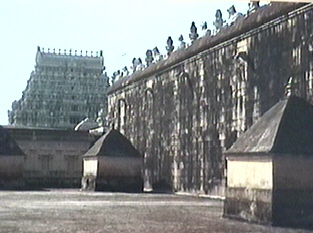As
vast as the Tiruvarur temple is the sprawling Kamalalayam
tank to the west of the temple. The tank forms a distinct landmark in this temple town.
The main entrance to the temple which covers an area of over 20 acres faces the east. The Kamalalayam
tank which is located to the west of the temple covers another 25 acres.

The temple has 3 prakarams
(circumambulatory paths) and a series of gopurams (towers) tapering in
size as one proceeds towards the sancta.
The Vanmikanathar shrine is amongst
the earliest of structures in the temple and is located in the innermost prakaram. The Tyagaraja shrine is located to the south of
the Vanmikanatha shrine within the same prakaram. Both the Vanmikanatha
and the Tyagaraja shrines share the same mukhamandapam.
Facing the shrine of Tyagaraja is a small shrine dedicated to Sundaramoorthy
Nayanar and his consort Paravai Naachiyaar.
Niche images of Dakshinamurthy, Vishnu and Bhramha
adorn the southern, western and northern sides of shrine dedicated to Tyagaraja.
Also in the innermost prakaram featuring these primary shrines, there are shrines
dedicated to Ganesha, Subramanya, the sixty three
nayanmars, Nataraja and Chandrasekhara.
The Neelotpalaambaal (consort of Vanmikanatha) shrine is located in the
second prakaram.
In the south east corner of the second prakaram is the Achaleswarar
shrine (Tiruvarur Araneri) whose structure dates back to the 10th century.
Also in the second prakaram are small shrines to Aatakeswarar, Aanandeswarar and
Siddheeswarar located in the southwest, northwest and north east corners.
Also in the second prakaram, directly in line with the Vanmikanathar
shrine is the Raajanarayanan Tirumandapam, a vast hall
lined with pillars.
The vast third prakaram houses a large shrine to Kamalaambal. This shrine
is a temple complex in itself. This structure dates back to the 16th century CE. The Kamalambal
shrine faces north east and is a complex of mandapams and circumambulatory passages.
The thousand pillared hall named as the Devasraya Mandapam
is located in the third prakaram and is lined with carved pillars.
A stone chariot depicting the legend of Manu Neethi Cholan, who
apparently chastised his son by running his chariot over him, for the sin of his (his
son's) having run over a calf thus killing it - at the behest of the bereaved cow is also
seen here.
A magnificient entrance (110 by 60 feet) pierces the eastern wall of the
outer prakaram and is crowned with a rajagopuram rising up to a height of 120 feet. The
appearance of the gopuram is markedly different from those at temples such as Madurai. It is a five tiered structure, abruptly
diminishing in size, topped with 11 kalasams. The tower dates back to the 13th century and
its base dates back to an earlier period.

A total of 7 towers define the skyline of the temple visible from a distance. The northern
and the western gopurams of the outer prakaram are later additions to the temple (17th -
18th centuries), but are stylistically similar to the earlier eastern (main) entrance.
The Shivastalam Aarur
Paravayumantali is located in the vicinity of this temple in the town of
Tiruvarur. It is an ancient shrine and it has been revered by the Tevram hymns of the
Tamil Saints.
